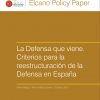Around one fifth of the 230 to 235 jihadists who between 2012 and 2018 travelled from Spain to Syria and Iraq as foreign terrorist fighters (FTFs) have already returned. There are currently 40 to 50 of these returnees. Most of them travelled initially with the purpose of joining the ranks of Islamic State –also known as ISIL or ISIS– or, to a lesser extent, organisations related to al-Qaeda. But some travelled in order to settle within territories where these jihadist organisations had either managed to temporarily impose their control or at least to establish a notable and influential presence.
“Not all returnees received training in the use of weapons and explosives or engaged in acts of violence and terrorism”
However, not all returnees received training in the use of weapons and explosives or engaged in acts of violence and terrorism while they were in Syria and Iraq. That is the case, for example, of several among the approximately 30 women who were part of the FTF contingent who left Spain for these two Middle-Eastern countries –around 13% of the total– but have returned. There are, for instance, women who came back, even as widows and with young children, after leaving Spain for reasons having to do more with their marital status or their early age than with a militant commitment.
However, among the Jihadist FTFs from Spain, there are men like Abdeluahid Sadik Mohamed who did not prove capable of dealing psychologically with the situation in which they found themselves immersed and returned. But there are also those who, like Ahmed Samsam, returned only to go back again onto the battlefield; and those who, like Benaissa Laghmouchi Baghdadi, returned to help send more FTFs recruited in Spain; or even those who, like Abdeljail Ait El Kaid, returned with the purpose of participating in the preparation and execution of attacks, including attacks on Spanish soil.
Some 20 of these returnees are now in prison, but only half of them are held in Spanish penitentiaries, where six were already serving sentences by the end of 2018, including all four of those mentioned above. The rest are imprisoned in Morocco, which is unsurprising because a majority of FTFs from Spain were Moroccan nationals. Moreover, only a few returnees imprisoned in Spain were arrested within the country. Most were apprehended in Turkey –the usual transit country for jihadists entering or exiting Syria–, but a few in Belgium, Bulgaria or Poland and then handed over to the Spanish authorities thanks to international arrest warrants.
Criminalisation is the first response in Spain to the phenomenon of returnees, given that they have committed crimes as defined by the national Criminal Code. Crimes such as, for instance, travelling to a foreign territory controlled by a terrorist organisation and settling in a foreign territory to receive training or to collaborate with a terrorist organisation. Yet enforcement of the law can be modulated according to the characteristics of returnees and the circumstances under which they originally departed, as in the case of women who returned to Spain with children in need of very special attention.
“Since 2016, an intervention programme has been underway in Spanish prisons with the purpose of distancing radicalised prisoners from extremism”
Furthermore, the incrimination of returnees, usually involving incarceration, does not exclude rehabilitation. Since 2016, an intervention programme has been underway in Spanish prisons with the purpose of distancing radicalised prisoners from extremism and bringing them closer to democratic values so that, once freed, they pose no danger to society. These radicalised inmates include returning FTFs who nevertheless remain adhered to the attitudes and beliefs of Salafi Jihadism. The problem is that more than half of the returnees who initially travelled from Spain to Syria and Iraq are not in prison.
Indeed, some 20 to 30 of these returnees remain at large. This typically occurs when, even though security forces or intelligence services are aware of the trajectory of such individuals, investigation into their activity fails to produce sufficient incriminating evidence. Such a situation implies a potential danger because returnees who maintain their jihadist ideas are likely to pose a terrorist threat in the short or medium term. It is known that the participation of foreign-fighter returnees tends to make the planning and preparation of attacks within western societies more effective and lethal.
Terrorists of these characteristics were among those making up the Jihadist network behind the 11 March 2004 Madrid train bombings. In any case, only around 10 of the returnees still at large are thought to be within Spain’s national territory. Some 10 to 20 more are now located outside Spain, mainly –though not exclusively– in Morocco. This suggests the extent to which the Spanish authorities can manage the problem of returned FTFs taking into account the phenomenon’s international dimension, highlighting the importance of counterterrorism cooperation with other countries, in this case especially with Morocco.
Concerning its domestic dimension, the basic challenge is applying the law in an individualised and appropriate manner to foreign-fighter returnees whose offences can be proved. This must be done while, on the one hand, developing initiatives aimed at facilitating the de-radicalisation and social integration of returned FTFs who are imprisoned in Spain, and, on the other, continuing to track returnees who remain at large in the country but for whose criminal offences there is as yet insufficient evidence, and improving the state’s ability to detect potential FTFs before they leave or, indeed, disrupt them in transit.



